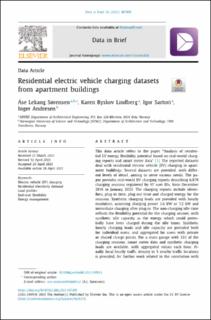| dc.description.abstract | This data article refers to the paper "Analysis of residential EV energy flexibility potential based on real-world charging reports and smart meter data" [1]. The reported datasets deal with residential electric vehicle (EV) charging in apartment buildings. Several datasets are provided, with different levels of detail, aiming to serve various needs. The paper provides real-world EV charging reports describing 6,878 charging sessions registered by 97 user IDs, from December 2018 to January 2020. The charging reports include identifiers, plug-in time, plug-out time and charged energy for the sessions. Synthetic charging loads are provided with hourly resolution, assuming charging power 3.6 kW or 7.2 kW and immediate charging after plug-in. The non-charging idle time reflects the flexibility potential for the charging session, with synthetic idle capacity as the energy which could potentially have been charged during the idle times. Synthetic hourly charging loads and idle capacity are provided both for individual users, and aggregated for users with private or shared charge points. For a main garage with 33% of the charging sessions, smart meter data and synthetic charging loads are available, with aggregated values each hour. Finally, local hourly traffic density in 5 nearby traffic locations is provided, for further work related to the correlation with plug-in/plug-out times. Researchers, energy analysts, charge point operators, building owners and policy makers can benefit from the datasets and analyses, serving to increase the knowledge of residential EV charging. The data provides valuable insight into residential charging, useful for e.g. forecasting energy loads and flexibility, planning and modelling activities. | |

